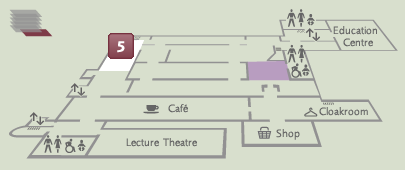Newberry Collection
Explore Percy and Essie Newberry's important collection of textiles including Islamic embroideries and Indian block-printed fragments.

Collection trails: 14 objects
- Reference URL
Actions
Textile fragment with star and pseudo-inscription
-
Details
- Associated place
- Material and technique
- linen, embroidered with red, yellow, and blue silk
- Dimensions
-
10 x 9.5 cm max. (length x width)
along length/width 17 / 19 threads/cm (thread count)
ground fabric 0.05 cm (thread diameter)
additional fibre, embroidery 0.04 cm (thread diameter)
- Material index
-
organic › animal › animal product › silk,
- Technique index
-
assembled › woven › plain woven,woven › plain woven,
- Object type index
- No. of items
- 1
- Credit line
- Presented by Professor Percy Newberry, 1941.
- Accession no.
- EA1993.357
-
Further reading
Ellis, Marianne, Embroideries and Samplers from Islamic Egypt (Oxford: Ashmolean Museum, in association with Greenville: Curious Works Press, 2001), no. 55 on p. 82, pp. 8 & 84, illus. p. 83
Barnes, Ruth and Marianne Ellis, ‘The Newberry Collection of Islamic Embroideries’, 4 vols, 2001, Oxford, Ashmolean Museum, cat. p. 318 (vol. iv), illus. vol. iv p. 318
Location
Objects are sometimes moved to a different location. Our object location data is usually updated on a monthly basis. Contact the Jameel Study Centre if you are planning to visit the museum to see a particular object on display, or would like to arrange an appointment to see an object in our reserve collections.
Collection trails
Galleries
Publications online
-

Embroideries and Samplers from Islamic Egypt
The immediate impression given by this fragment is that its geometric design is remarkably like the Roman mosaic floor patterns based on stars within squares. The design can also be compared to the more elaborate compositions with eight-pointed stars within octagons seen on 16th century Mamluk carpets. It is intriguing to see the way the design has been built up from the central star within an octagon, within another square surrounded by a border and then multiplied to form a larger pattern. On closer inspection we realise that the repeating motif in the border is ultimately derived from kufic script. It is similar to that seen on fragment No.18 [EA1993.76] and could be derived from the Arabic words for "health" or possibly from "Allah".
The embroidery is worked in spaced cross stitch and close counted herringbone stitch as seen on No.39 [EA1993.153]. Here it functions as both a line and a filling stitch and is found on a wide range of designs broadly similar to those worked in pattern darning and double running during the Mamluk period. -

The Newberry Collection of Islamic Embroideries
A central eight-pointed blue star is set in a red square with a lattice border, surrounded by pseudo Kufic motifs placed alternately.
The pseudo inscription of the border is derived from al-mulk, 'the kingdom'.
The textile has a radiocarbon date of 1189 Ad +/- 34, with a calibrated range of 1210 to 1300. It is likely to be of Mamluk date.
© 2013 University of Oxford - Ashmolean Museum




